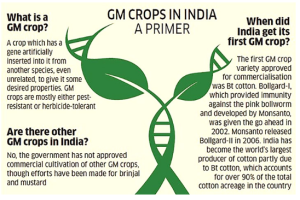Context:
Environmentalists in the Supreme Court of India are fiercely opposing Delhi University’s genetically modified (GM) herbicide-tolerant (HT) mustard.
Genetic Modification (GM):
- It is a technique to obtain desired characters by modifying the DNA of the organism by inserting genes from the same or another (foreign) species.
- Traditional breeding involves selecting traits over many generations, whereas GM technology manipulates the genes directly.

Genetically Modified (GM) Crops:
- These are the plants whose DNA has been modified through genetic engineering to obtain the characters in the plants which do not occur naturally in the species.
- The introduction of GM crops started with the approval of the Flavr Savr tomato in the USA in 1994
Image Source: Editorial Video PWOnlyIAS
Benefits of GM Crops:
- Resistance to Pest & Diseases: Bt-cotton is the only approved GM crop (2002) for commercial cultivation in India.
- It was introduced to produce Bt toxin which helps to kill certain insects but is not harmful to humans or other animals.
- Virus Resistance: Virus-resistant traits are introduced in susceptible plants which do not possess natural resistance.
- GM Papaya was created to resist the papaya ringspot virus in Hawaii.
- High Yield: GM Mustard was produced with a primary objective to obtain higher yield.
- In India, GM mustard has not been released for commercial cultivation yet. If released, it would be India’s first edible GM crop.
- Increase Shelf Life: In Flavr Savr Tomatoes, the anti-freezing property from an arctic fish was introduced in tomatoes to increase their shelf life.
- Herbicide Tolerance (HT): GM crops are created with resistance to specific herbicides which can be used to manage weeds. HT crops reduce soil erosion as weed removal requires ploughing, leading to erosion.
- HT crops include corn, cotton and soybeans.
- Aesthetic Changes: The Arctic apple has the special ability to resist browning after being cut, which protects its flavor and nutritional value.
- Enhanced Nutritional Quality: Vitamin A-rich crops such as Golden Rice.
- Reduced Costs for Food: They require fewer pesticides, land and water, hence, GMOs help keep food production costs down resulting in lower prices for consumers.
- Environment & Pollution Control: They are tolerant to drought, hence reducing the use of groundwater.
-
Concerns with the GM Crops:
- Disruption of Natural Gene Flow: There is a high risk to the disruption of ecosystem and biodiversity because the “better” traits produced from engineering genes can result in the favoring of one organism.
- It reduces genetic diversity, which is crucial for adapting to new environments, and as a protection of the species against diseases.
- Increase in Cost Cultivation: It increases the cost of cultivation and is more inclined towards marketization of farming that works on immoral profits.
- Long-term research suggests that Bt cotton has provided only fleeting benefits to farmers, while some seed companies have profited handsomely from the expensive GM seeds.
- Environment Threat: The transgenic crops endanger not only farmers but also the trade, and the environment as well.
- Most herbicides degrade quickly in the soil but the rate of degradation depends on soil temperature and moisture levels. However, some studies have reported undesired effects of herbicide residue on soil.
- Effect on Honeybees and Other Pollinators: There is a concern that GM crops may pose a potential risk to the honeybee population and other pollinators, which is directly a threat to the biodiversity and environment.
- As per a Technical Expert Committee (TEC), appointed by the Supreme Court, HT crops are completely unsuitable in the Indian context and warned of serious harm to the environment, rural livelihoods and sustainable agriculture if they were released.
- Inadequate Safety Assessments: The regulatory regime in India about GM crops has never been assessed thoroughly about the GM risk assessment in Indian conditions.
- Impact on Human Health: An example of a potential adverse effect of a GM trait on human health comes from Australia.
- Toxins from beans were put in field peas to kill insects which used to destroy almost 30% of the yield.
- The feeding trials on animals indicated negative results, and the development of GM field peas was discontinued.
- Impact of Herbicide-Tolerant and Pest-Resistant crops: Overuse of herbicides on fields with herbicide-tolerant GM or non-GM crops can allow weeds to develop resistance against them.
- Glyphosate has been used as a herbicide in the USA since 1974, and its extensive use has led to glyphosate-resistant weeds.
Conclusion:
While allowing GM crops, it is necessary to ensure that the adverse consequences do not arise. The challenges linked to GM crops need to be addressed by the governments, especially in the areas of safety testing, regulation and food labeling.
| Additional Information:
Associated Organizations:
- Review Committee on Genetic Manipulation (RCGM):
- Under the Department of Biotechnology (DBT), this committee monitors various aspects of Research & Development projects involving GM organisms.
- Genetic Engineering Appraisal Committee (GEAC):
- Under the Ministry of Environment, it is responsible for the assessment of proposals related to the release of GM organisms and products into the environment.
Associated Legislation:
- Environment Protection Act, 1986:
- Regulation of GM Crops is primarily governed by “The Manufacture, Use, Import, Export and Storage of Hazardous Microorganisms Genetically Engineered Organisms or Cells Rules, 1989”.
International Organization:
- United Nations Cartagena Protocol on Biosafety (2000):
- Signatory countries may take a decision to minimize potential adverse effects on biological diversity and risks to human health with regard to import of living (genetically) modified organisms.
|
News Source: The Hindu
![]() 19 Jul 2023
19 Jul 2023

